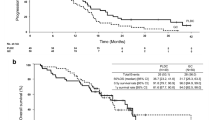Abstract
Background
Both gemcitabine and pegylated liposomal doxorubicin (PLD) are antineoplastic drugs with clinical activity in patients with platinum-resistant ovarian cancer. The present study was designed to assess the efficacy and safety of biweekly scheduled gemcitabine and PLD combination therapy in such patients.
Methods
Eighteen women with ovarian cancer that had recurred within 6 months after standard carboplatin and paclitaxel therapy were eligible for enrollment. Gemcitabine 2000 mg/m2 and PLD 20 mg/m2 were administered intravenously on days 1 and 15 of a 28-day cycle.
Results
Hematological toxicity was mild. No severe (grade III/IV) leucopenia/neutropenia or thrombocytopenia was observed. Severe anemia was seen in only 3 (17%) patients. Several other severe nonhematological adverse effects were well tolerated and easily managed. The overall response rate was 28% (5 of 18; 95% confidence interval [CI], 10%–54%) with 2 (11%) complete and 3 (17%) partial responses. The median overall survival time was 17 months (range, 1 to 25 months). The median survival for patients with clinical benefit including disease response or stabilization was 17 months (range, 3 to 26 months) compared to that of patients with progressive disease, which was 2 months (range, 1 to 11 months; P = 0.04).
Conclusion
A biweekly schedule of gemcitabine combined with PLD is an active and safe chemotherapy regimen with acceptable and easily manageable toxicities in women with recurrent platinum-resistant ovarian cancer.
Similar content being viewed by others
References
Colombo N, Van Gorp T, Parma G, et al. (2006) Ovarian cancer. Crit Rev Oncol Hematol 60:159–179
Shapiro JD, Millward MJ, Rischin D, et al. (1996) Activity of gemcitabine in patients with advanced ovarian cancer: responses seen following platinum and paclitaxel. Gynecol Oncol 63:89–93
D’Agostino G, Amant F, Berteloot P, et al. (2003) Phase II study of gemcitabine in recurrent platinum-and paclitaxel-resistant ovarian cancer. Gynecol Oncol 88:266–269
Gordon A, Fleagle JT, Guthrie D, et al. (2001) Recurrent epithelial ovarian carcinoma: a randomized phase III trial of pegylated liposomal doxorubicin versus topotecan. J Clin Oncol 19:3312–3322
Gordon AN, Granai CO, Rose PG, et al. (2000) Phase II study of liposomal doxorubicin in platinum-and paclitaxel-refractory epithelial ovarian cancer. J Clin Oncol 18:3093–3100
Muggia FM, Hainsworth JD, Jeffers S, et al. (1997) Phase II study of liposomal doxorubicin in refractory ovarian cancer: antitumor activity and toxicity modification by liposomal encapsulation. J Clin Oncol 15:987–993
Gallo D, Fruscella E, Ferlini C, et al. (2006) Preclinical in vivo activity of a combination gemcitabine/liposomal doxorubicin against cisplatin-resistant human ovarian cancer (A2780/CDDP). Int J Gynecol Cancer 16:222–230
Fracasso PM, Blum KA, Tan BR, et al. (2002) Phase I study of pegylated liposomal doxorubicin and gemcitabine in patients with advanced malignancies. Cancer 95:2223–2229
Petru E, Angleitner-Boubenizek L, Reinthaller A, et al. (2006) Combined PEG liposomal doxorubicin and gemcitabine are active and have acceptable toxicity in patients with platinum-refractory and-resistant ovarian cancer after previous platinum-taxane therapy: a phase II Austrian AGO study. Gynecol Oncol 102:226–229
Skarlos DV, Kalofonos HP, Fountzilas G, et al. (2005) Gemcitabine plus pegylated liposomal doxorubicin in patients with advanced epithelial ovarian cancer resistant/refractory to platinum and/or taxanes. A HeCOG phase II study. Anticancer Res 25:3103–3108
Ferrandina G, Paris I, Ludovisi M, et al. (2005) Gemcitabine and liposomal doxorubicin in the salvage treatment of ovarian cancer: updated results and long-term survival. Gynecol Oncol 98:267–273
Holloway RW, Finkler NJ, Nye LP, et al. (2004) Doxil and gemcitabine combination therapy for recurrent ovarian cancer: results of a phase II trial. ASCO Annual Meeting Proceedings. J Clin Oncol 22:5090
D’Agostino G, Ferrandina G, Ludovisi M, et al. (2003) Phase II study of liposomal doxorubicin and gemcitabine in the salvage treatment of ovarian cancer. Br J Cancer 89:1180–1184
Oskay G, Sehouli J, Katsares I, et al. (2004) Biweekly schedule of pegylated liposomal doxorubicin (PLD) induces low rates of skin toxicities: results of a phase II trial in heavily pretreated patients with relapsed ovarian cancer. ASCO Annual Meeting Proceedings. J Clin Oncol 22:5072
Author information
Authors and Affiliations
Corresponding author
About this article
Cite this article
Tas, F., Guney, N., Derin, D. et al. A pilot study evaluating the efficacy and toxicity of biweekly gemcitabine and pegylated liposomal doxorubicin in recurrent platinum-resistant epithelial ovarian cancer. Int J Clin Oncol 13, 156–160 (2008). https://doi.org/10.1007/s10147-007-0740-4
Received:
Accepted:
Published:
Issue Date:
DOI: https://doi.org/10.1007/s10147-007-0740-4




